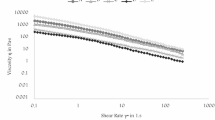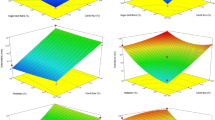Abstract
This study focused on the formulation of food products, based on sesame and carob. The possibility of developing blends from sesame paste and carob molasses, using molasses concentrations of 30, 40 and 50%, at 60, 70 and 80°Brix, respectively, has been studied. The blend prepared with 50% carob molasses at 60°Brix was found to be the most acceptable product, according to a sensory acceptability test. Sesame paste, supplemented with carob molasses, was evaluated for physical quality (oil separation, colour and texture) and nutritional composition (moisture, sugar, protein, fat, ash and polyphenols). Physical analysis showed that the addition of carob molasses to sesame paste improved its emulsion stability, changed its colour from beige to brown and modified its texture from fluid to solid. Nutritional analysis proved that mixing sesame paste with carob molasses provided a natural product, characterized by interesting nutritional value (protein: 16.97 g/100 g fry matter, fat: 12.05 g/100 g fry matter and sugar: 9.34 g/100 g fry matter), arising from the constituents of the two ingredients. Thus, the developed blend could offer a promising nutritious and healthy foodstuff to consumers.



Similar content being viewed by others
References
Abu-Jdayil B, Al-Malah K, Asoud H (2002) Rheological characterization of milled sesame (tehineh). Food Hydrocolloid 16:55–61
Alpaslan M, Hayta M (2002) Rheological and sensory properties of pekmez (grape molasses)/tahin (sesame paste) blends. J Food Eng 54:89–93
AOAC (2000) Official methods of analysis (17th ed). Association of Official Analytical Chemists, Washington, USA
Arslan E, Yener ME, Esin A (2005) Rheological characterization of tahin/pekmez (sesame paste/concentrated grape juice) blends. J Food Eng 69:67–172
Biner B, Gubbuk H, Karhan M, Aksu M, Pekmezci M (2007) Sugar profiles of the pods of cultivated and wild types of carob bean (Ceratonia siliqua L.) in Turkey. Food Chem 100:1453–1455
CIE (1986) Colorimetry (Supplement N°2, Publication N°15). Commision International de l’Eclairage, Paris
Dhaouadi K, Belkhir M, Akinocho I, Raboudi F, Pamies D, Barrajón E, Fattouch S (2014) Sucrose supplementation during traditional carob syrup processing affected its chemical characteristics and biological activities. LWT-Food Sci Technol 57:1–8
Dubois M, Gilles KA, Hamilton JK, Rebers PA, Smith F (1956) Colorimetric method for determination of sugars and related substances. Anal Chem 28:350–356
El Gerssifi M (1997) Les défauts des produits de pâtisserie et biscuiterie au cours du stockage: la prévention par la formulation. In 6ème Colloque de l’Alliance 7/CEDUS: Formulation et durée de vie des produits riches en sucre, pp 45–54
Elleuch M, Besbes S, Roiseux O, Blecker C, Attia H (2007) Quality characteristics of sesame seeds and by-products. Food Chem 103:641–650
Elleuch M, Bedigian D, Maazoun B, Besbes S, Blecker C, Attia H (2014) Improving halva quality with dietary fibres of sesame seed coats and date pulp, enriched with emulsifier. Food Chem 145:765–771
Haddarah A, Ismail A, Bassal A, Hamieh T, Ghoul M (2013) Morphological and chemical variability of lebanese carob varieties. Eur Sci J 9:1857–7881
IEC (1999) Multimedia systems and equipment - Colour measurement and management (International Standard 61966-2-1). International Electrotechnical Commission, Geneva
Maskan M, Göğüş F (2000) Effect of sugar on the rheological properties of sun flower oil in water emulsions. J Food Eng 43:173–177
McGuire RG (1992) Reporting of objective color measurements. HortScience 27:1254–1255
Özcan MM, Arslan D, Gökçalik H (2007) Some compositional properties and mineral contents of carob (Ceratonia siliqua) fruit, flour and syrup. Int J Food Sci Nutr 58:652–658
Razavi SMA, Habibi Najafi MB, Alaee Z (2007) The time independent rheological properties of low fat sesame paste/date syrup blends as a function of fat substitutes and temperature. Food Hydrocolloid 21:198–202
Sengül M, Ertugay MF, Sengül M, Yüksel Y (2007) Rheological characteristics of carob Pekmez. Int J Food Prop 10:39–46
Singleton VL, Rossi JA (1965) Colorimetry of total phenolics with phosphomolybdic-phosphotungstic acid reagents. Am J Enol Viticult 16:144–158
Tetik N, Turhan İ, Karhan M, Öziyci HR (2010) Characterization of, and 5-hydroxymethylfurfural concentration in carob Pekmez. GIDA 35:417–422
Tetik N, Turhan I, Oziyci HR, Karhan M (2011) Determination of D-pinitol in carob syrup. Int J Food Sci Nutr 62:572–576
Toker OS, Dogan M, Ersöz NB, Yilmaz MT (2013) Optimization of the content of 5-hydroxymethylfurfural (HMF) formed in some molasses types: HPLC-DAD analysis to determine effect of different storage time and temperature levels. Ind Crops Prod 50:137–144
Tounsi L, Kechaou N (2017) Le caroubier (Ceratonia siliqua L.) et ses fruits: descriptions, intérêts et applications. Éditions Universitaires Européennes, Sarrebruck, Allemagne
Tounsi L, Karra S, Kechaou H, Kechaou N (2017) Processing, physico-chemical and functional properties of carob molasses and powders. J Food Meas Charact 11:1440–1448
Acknowledgements
The authors would like to thank the industry “Confiserie Triki-le Moulin” (Sfax, Tunisia) for the financial support and analytical assistance. The authors are also grateful to Mrs. Neila Bahloul, assistant professor in Science Faculty of Sfax, for her help in the manuscript revision.
Author information
Authors and Affiliations
Corresponding author
Additional information
Publisher's Note
Springer Nature remains neutral with regard to jurisdictional claims in published maps and institutional affiliations.
Rights and permissions
About this article
Cite this article
Tounsi, L., Kchaou, H., Chaker, F. et al. Effect of adding carob molasses on physical and nutritional quality parameters of sesame paste. J Food Sci Technol 56, 1502–1509 (2019). https://doi.org/10.1007/s13197-019-03640-w
Revised:
Accepted:
Published:
Issue Date:
DOI: https://doi.org/10.1007/s13197-019-03640-w




